Winter Weather patterns over the Northern Hemisphere are produced by different drivers. New data and studies show a very important role of a larger October snow cover across the Northern Hemisphere. It impacts the Polar Vortex indirectly, creating a long-term effect on winter weather in the United States, Canada, and Europe.
The atmospheric circulation is very delicate and complex, so larger anomalies can create a strong imbalance in the flow. A larger snow extent in Autumn can destabilize the Polar Vortex, helping to create a more disrupted (colder) Winter pressure pattern.
First, we will quickly revisit the Polar Vortex and how it works. Then, you will see how a larger snow cover in October can bring more snow and cold to the United States and Europe in the winter. Also, we will analyze the current state of the snow extent and how large it will get for the 2024/2025 cold weather season.

THE POLAR CIRCULATION
As we head into autumn, the polar regions start to cool. Less energy reaches the North Pole as the Sun gets lower. But as the polar temperatures drop, the atmosphere further to the south is still warmer as it receives light and energy from the Sun.
This causes a strong global pressure difference between the polar and sub-tropical regions, and a large low-pressure (cyclonic) circulation starts to develop across the Northern Hemisphere. It extends from the surface layer far up into the Stratosphere. This is known as the Polar Vortex.
Below is a 3-dimensional image of the Polar Vortex, extending from the lower levels up into the Stratosphere. The vertical axis is greatly enhanced for better visual presentation. You can see what the actual winter structure of the Polar Vortex looks like.

The upper (stratospheric) part is more circular and symmetrical as it spins higher above the ground and has little interference. But the lower structure of the Polar Vortex is much more uneven and disrupted. That is due to the influence of the terrain/mountains and strong pressure systems acting as obstacles in the flow.
In the image below, you can see an example of the high-altitude Polar Vortex at around 30km/18.5miles in the middle Stratosphere during Winter. It is typically circular, with the temperature in its core reaching down to -90 Celsius (-130F) when it is at its strongest.

The stronger winds are typically found in the outer edge, called “the surf zone”. Winds are important when describing the Polar Vortex, as they are usually the first to show that something is changing.
To summarize, the Polar Vortex behaves like a very large cyclone, covering the whole north pole down to the mid-latitudes. It is connected through all levels of the atmosphere, from the ground up, but has different shapes at different altitudes.
We monitor any Polar Vortex activity because it can affect weather across the entire Northern Hemisphere. Especially during the winter season, and that is regardless if it is weak or strong.
A strong Polar Vortex usually means strong polar circulation. This usually locks the colder air into the Polar regions, creating milder conditions for most of the United States and Europe.
In contrast, a weak Polar Vortex can create a weak jet stream pattern. It has a more challenging time containing the cold air, which can now escape from the polar regions into the United States and/or Europe. Image by NOAA.
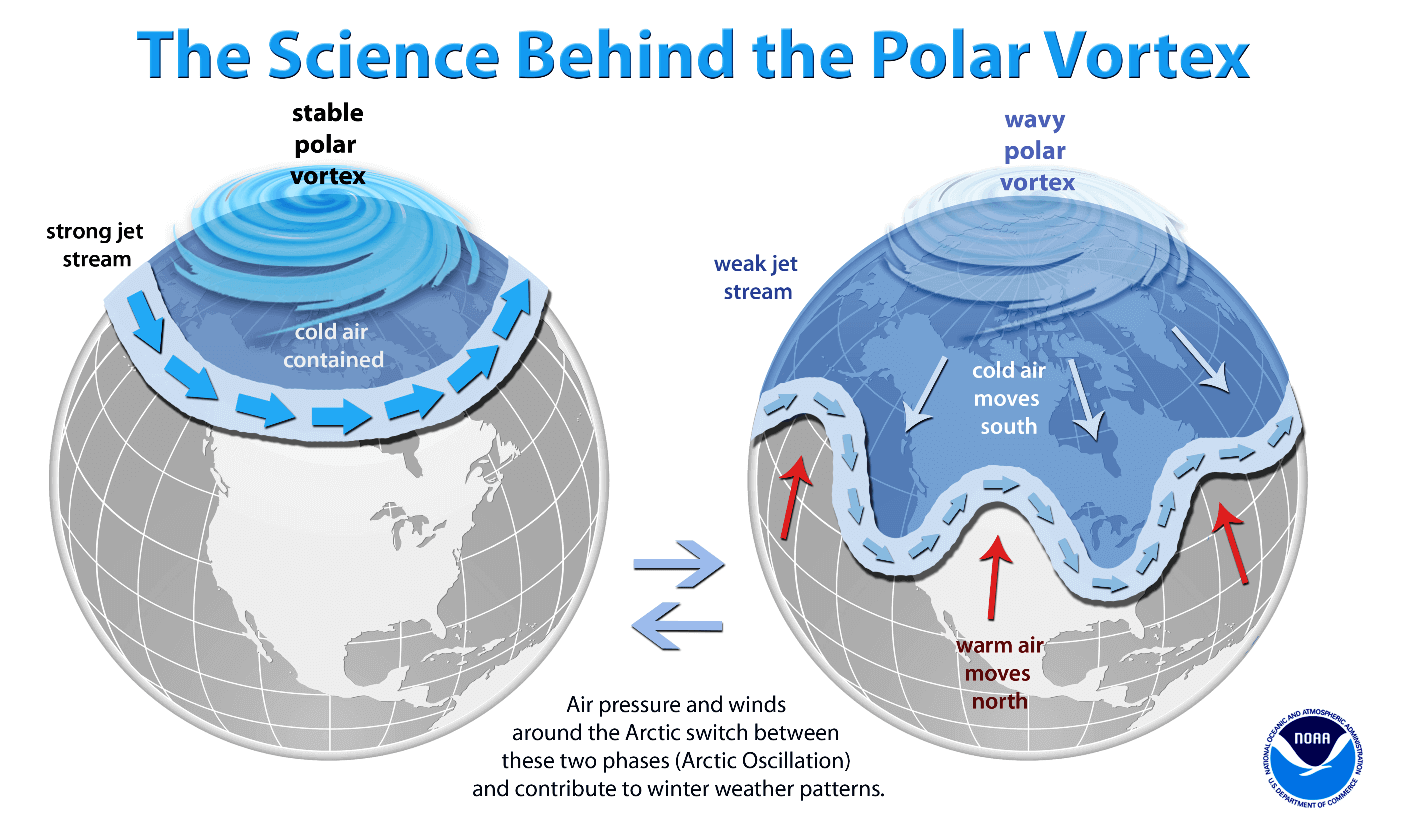
To put the Polar Vortex into perspective, we produced a high-resolution video below from NASA data, showing the vortex spinning over the Northern Hemisphere in the Stratosphere at the 30mb level (22km/14miles altitude).
The most important thing to take away from the video should be that the Polar Vortex is not just one winter storm or a cold outbreak that moves from the Midwest into the northeastern United States.
The Polar Vortex is a large cyclonic area spinning over the entire Northern Hemisphere, from the ground up to the top of the Stratosphere and beyond, reaching over 50km/31miles altitude. It plays a major role in weather patterns and circulation across the Northern Hemisphere.
FROM OCTOBER SNOW TO WINTER COLD
The Polar Vortex is very important, even before we get to Winter. Many factors can have an effect in the long term. There is one special way that the Autumn weather patterns in the lower levels can impact the Polar Vortex in the long run.
Weather patterns can influence the Polar Vortex by building an extensive snow cover over Siberia. Multiple studies have proved that the snow cover extent in October over Siberia weakens the stratospheric Polar Vortex at a later period.
You can see a simple month-by-month diagram below, indicating the timeline of how a high snow cover over Siberia impacts the stratospheric Polar Vortex in winter.
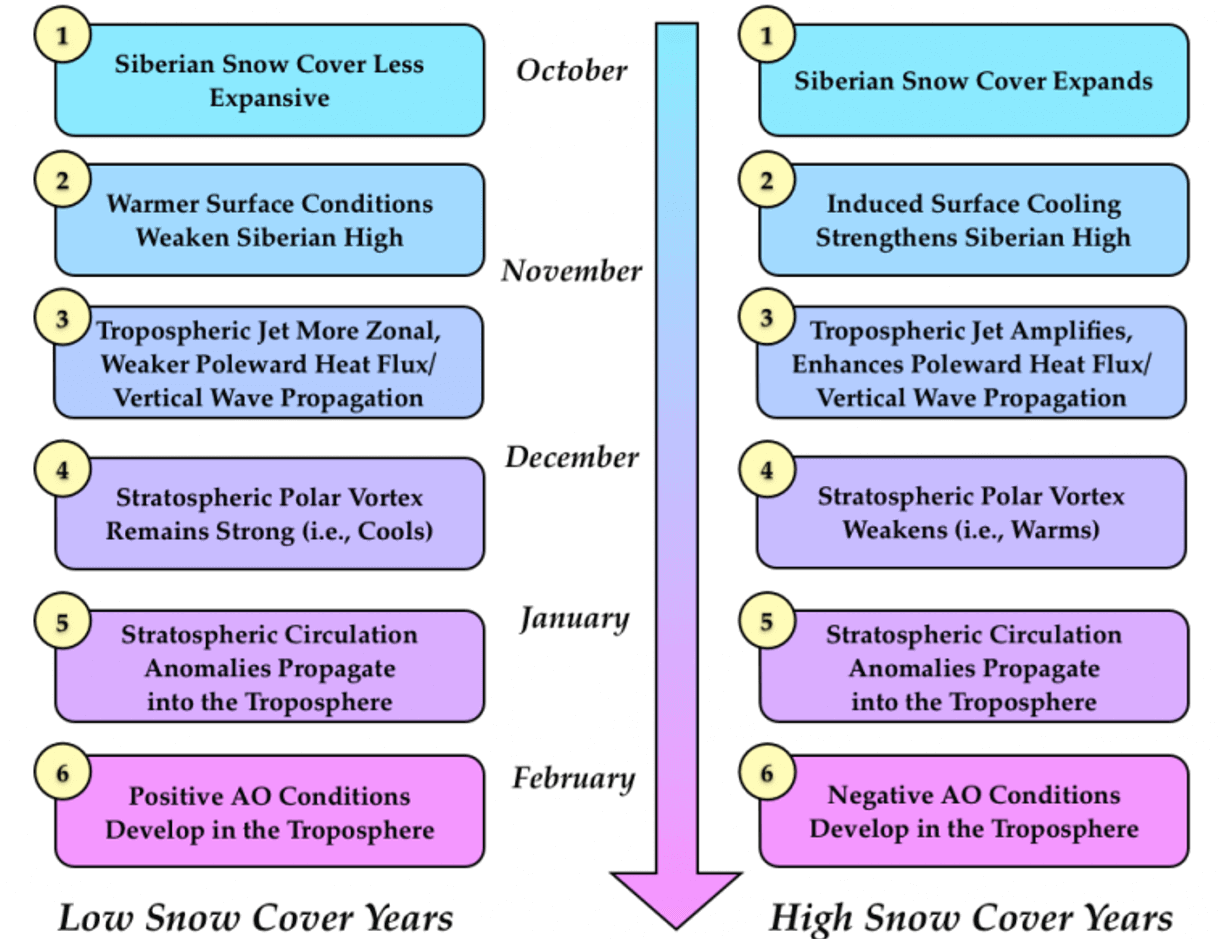
A stronger winter high-pressure system can develop over the region due to snow cover. Then, this stronger high-pressure area affects the Polar Vortex, as it helps to send more vertical energy up into the Stratosphere.
A weaker Polar Vortex naturally means weaker polar circulation and a greater chance of cold air outbreaks over the United States and Europe during Winter. Below, you can see the basic schematic of the changing Polar Vortex circulation in an even simpler way.
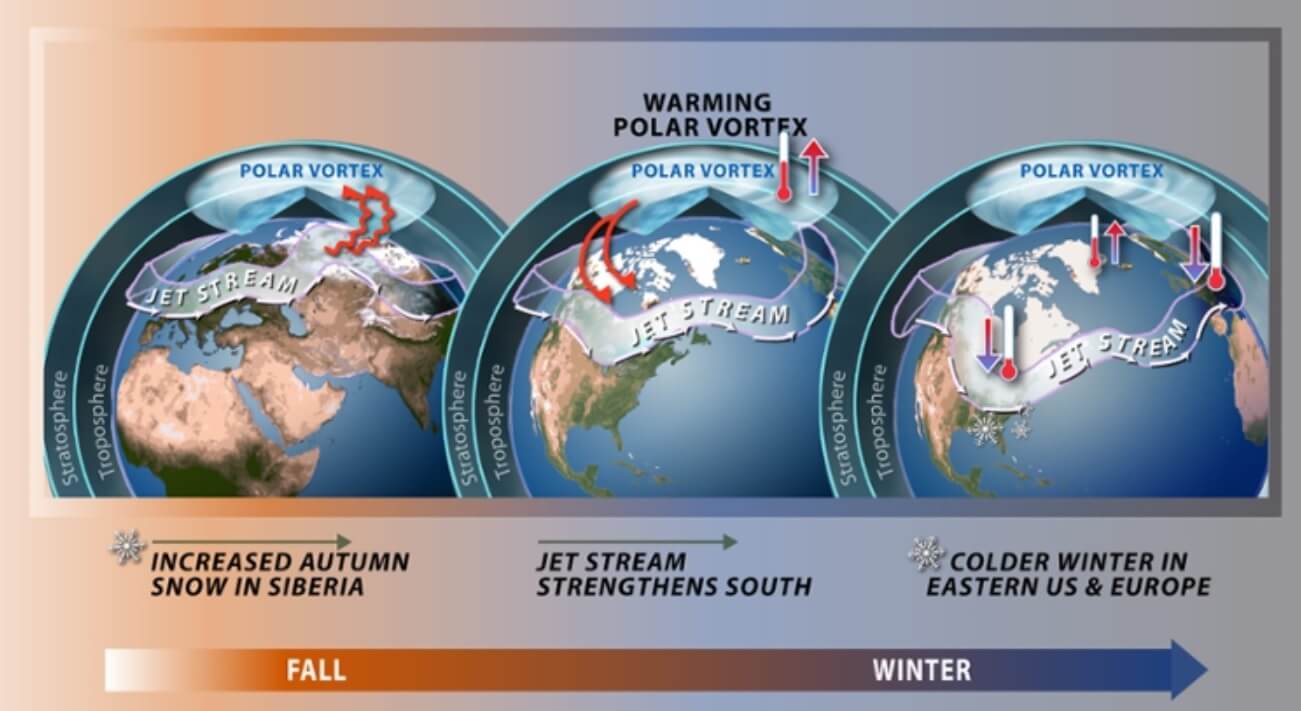
The next image below shows the snow cover extent for Eurasia and North America in October, compared to the stratospheric Polar Vortex strength in December, measured by the strength of the stratospheric polar jet. Years are in order by the highest Eurasian October snow cover on the left and lowest on the right.
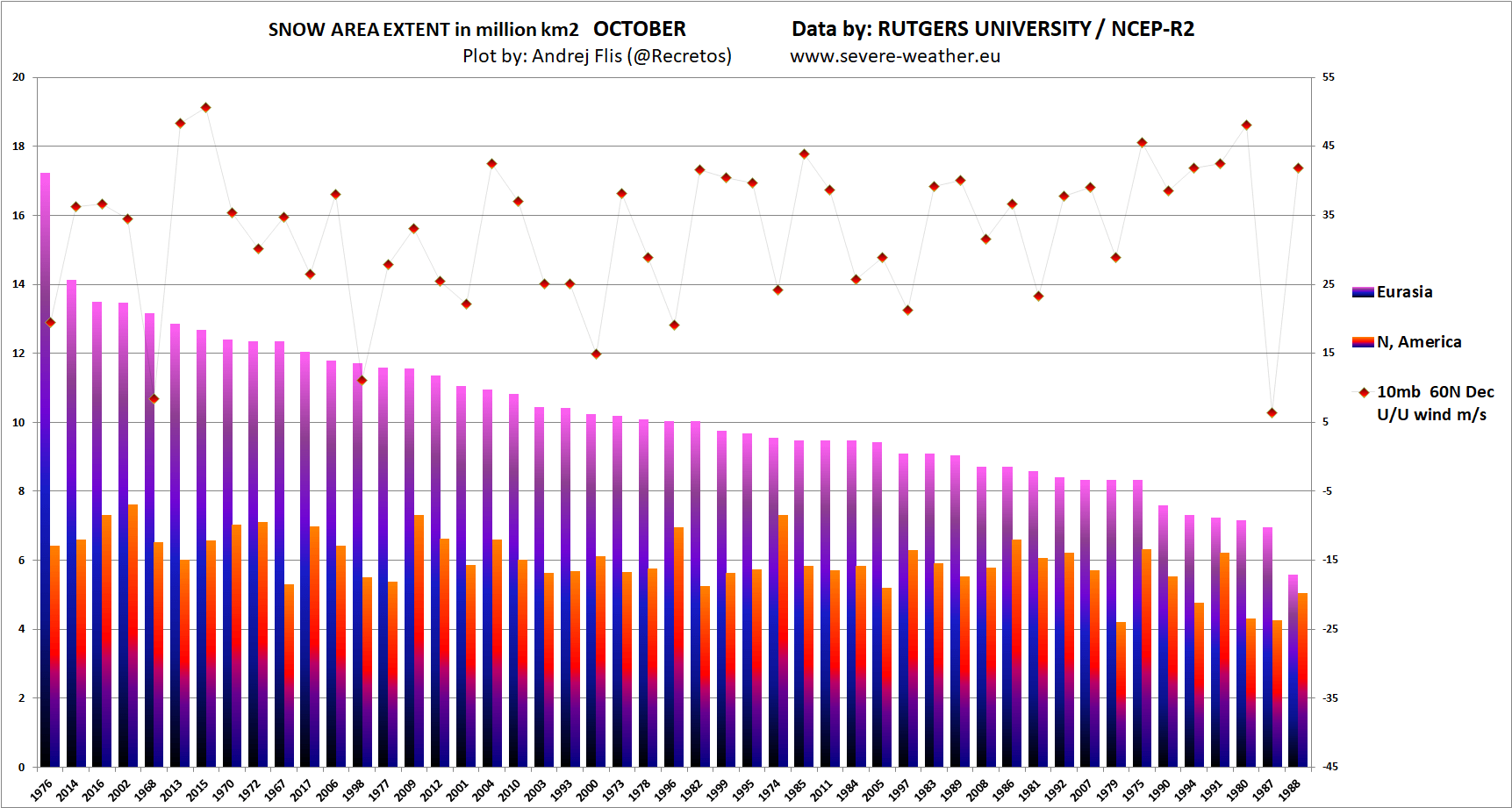
Looking at the graph above, we can take the top 5 snow cover years and compare the following winters to the lowest five snow cover years. The top 5 years with the highest October snow extent are 1976,2014,2016,2002 and 1968.
Below are Winter pressure anomalies for the 5 winters following the highest October snow extent. You can see a very interesting pattern: high pressure over the polar regions and disrupted circulation. Low-pressure areas span from the eastern United States into the North Atlantic.
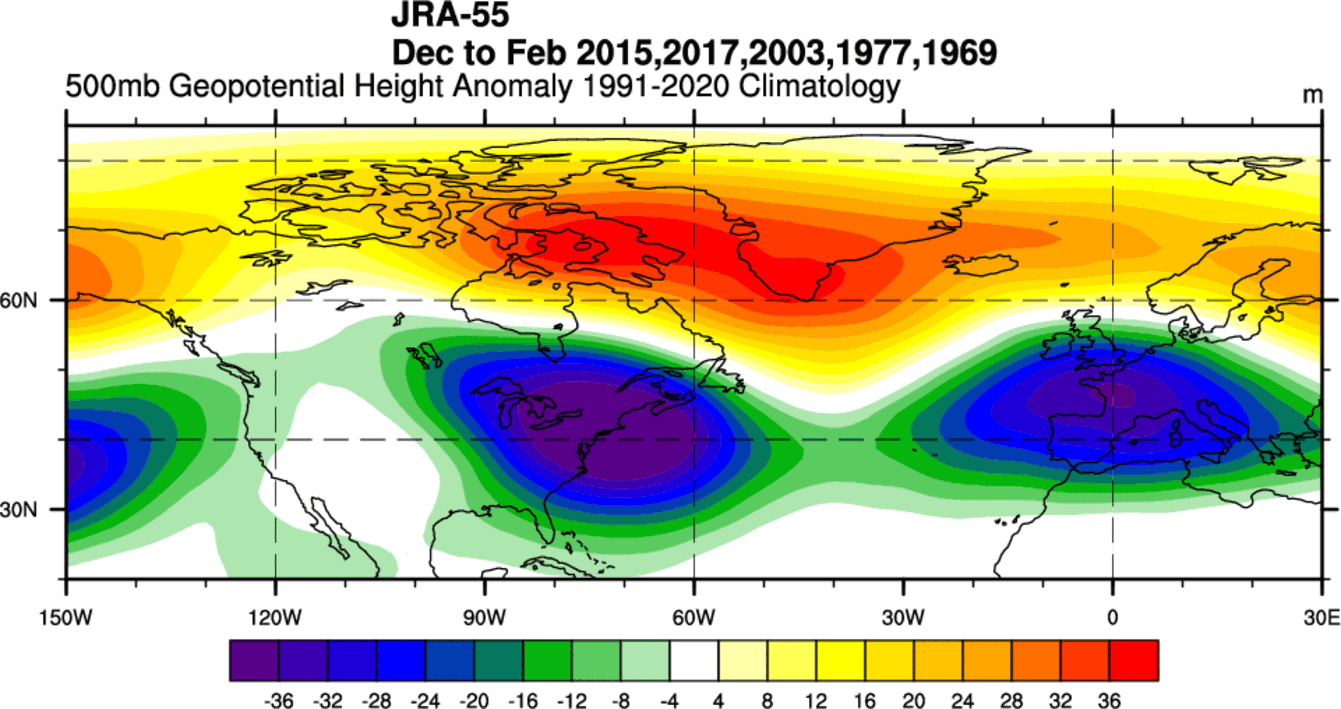
The winter temperature anomalies from this pressure pattern are also interesting, with the colder air being released into the mid-latitudes. We can see cold air over much of the northern and eastern United States and Europe.
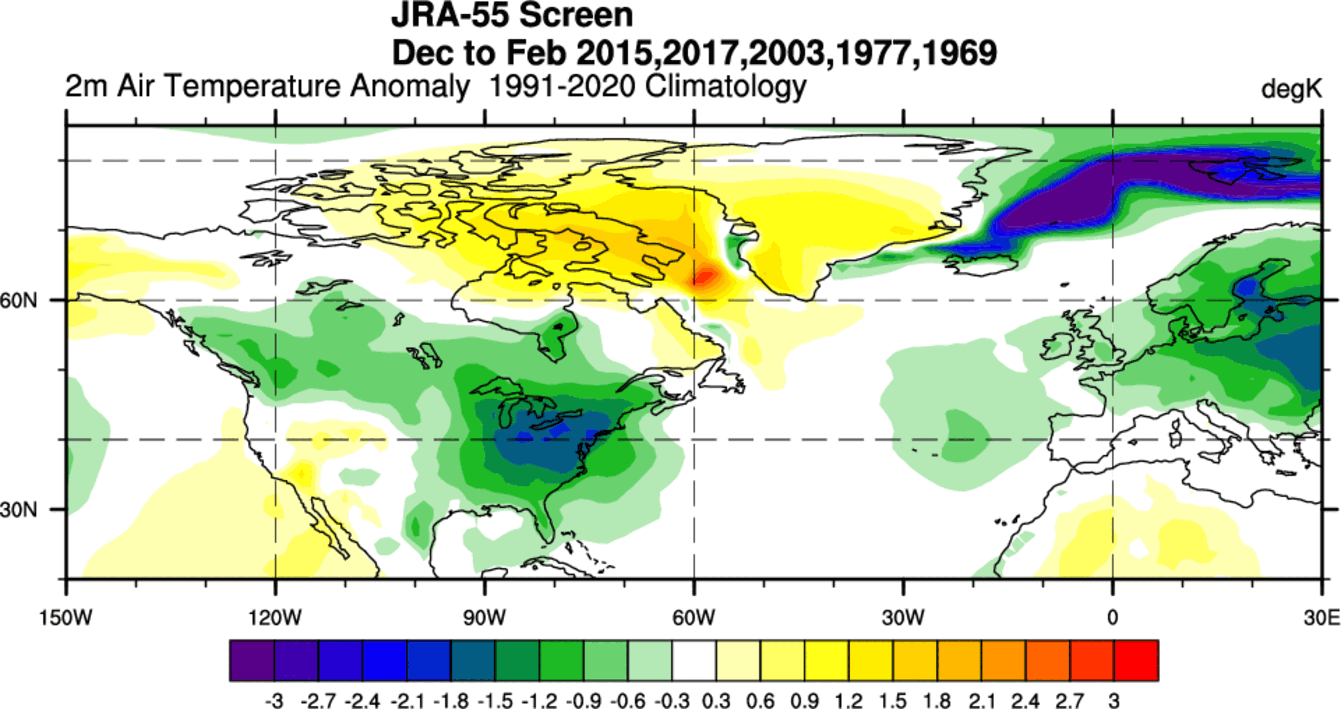
From this, you can see that having a larger October snow extent can mean a colder Winter and more snowfall over the United States and Europe. So, having a large October snow extent should be on your bucket list if you are a fan of cold and snow during winter.
WINTER POLAR VORTEX SHIFT
Using the same 5 highest October snow extent years, we will also look at the stratospheric Polar Vortex and its circulation. We normally use the 10mb level (30km/18.5miles altitude) to represent the stratospheric layers.
Looking at the high snow extent years below, we can see a higher pressure tendency in the stratosphere. This means a weaker Polar Vortex and, with coupling, a weaker lower-level circulation. Such a pattern helps to unlock the cold air out of the polar regions at the surface.
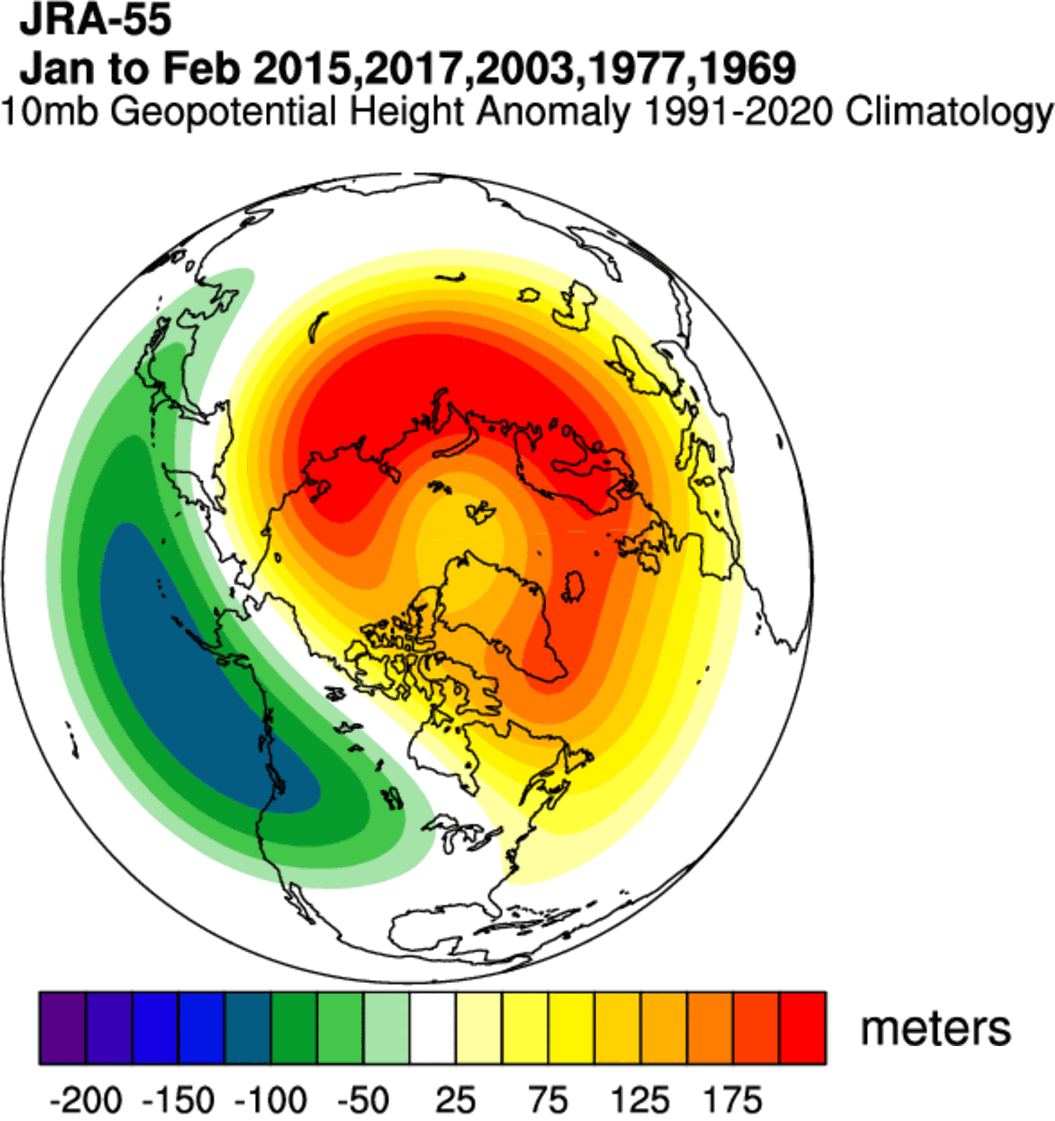
The image below shows the stratospheric temperatures for the same years. We can see a strong warming tendency around and over the polar regions. This further shows the weakening process of the Polar Vortex in the stratosphere in Winter following a high October snow extent.

But the strength of the global circulation is not measured just by pressure and temperature but also by the winds. As mentioned before, we use wind speeds to monitor the state/health of the Polar Vortex. So below, we will compare two images with vertical wind and temperature patterns for high snow extent years.
The image below shows you atmospheric anomalies for each month, following a high snow cover extent over Eurasia. In the left square for each month is the temperature anomaly, and the right square is the wind anomaly. Image from a study by Martin Wegmann et al.

What this shows us is that in a year with high snow extent over Siberia, the Polar Vortex is warmer and weaker. That has an impact on the overall northern circulation and weather patterns.
Remember, the weaker the Polar Vortex and its circulation, the more disrupted the weather patterns can get. That makes it easier for the cold air to escape the polar circle and move southward into the United States, Canada, and Europe.
So now that we know what a difference the October snow extent can make in the circulation and weather, what is the current data? And what does the snowfall forecast show for the rest of the month?
SNOW COVER OVER NORTHERN HEMISPHERE
Below is the high-resolution snow depth analysis from the United States GFS model, run by the NCEP. It shows the area of the Northern Hemisphere covered by snow. We can see a quite significant extent over Siberia but a slightly lower extent over North America.
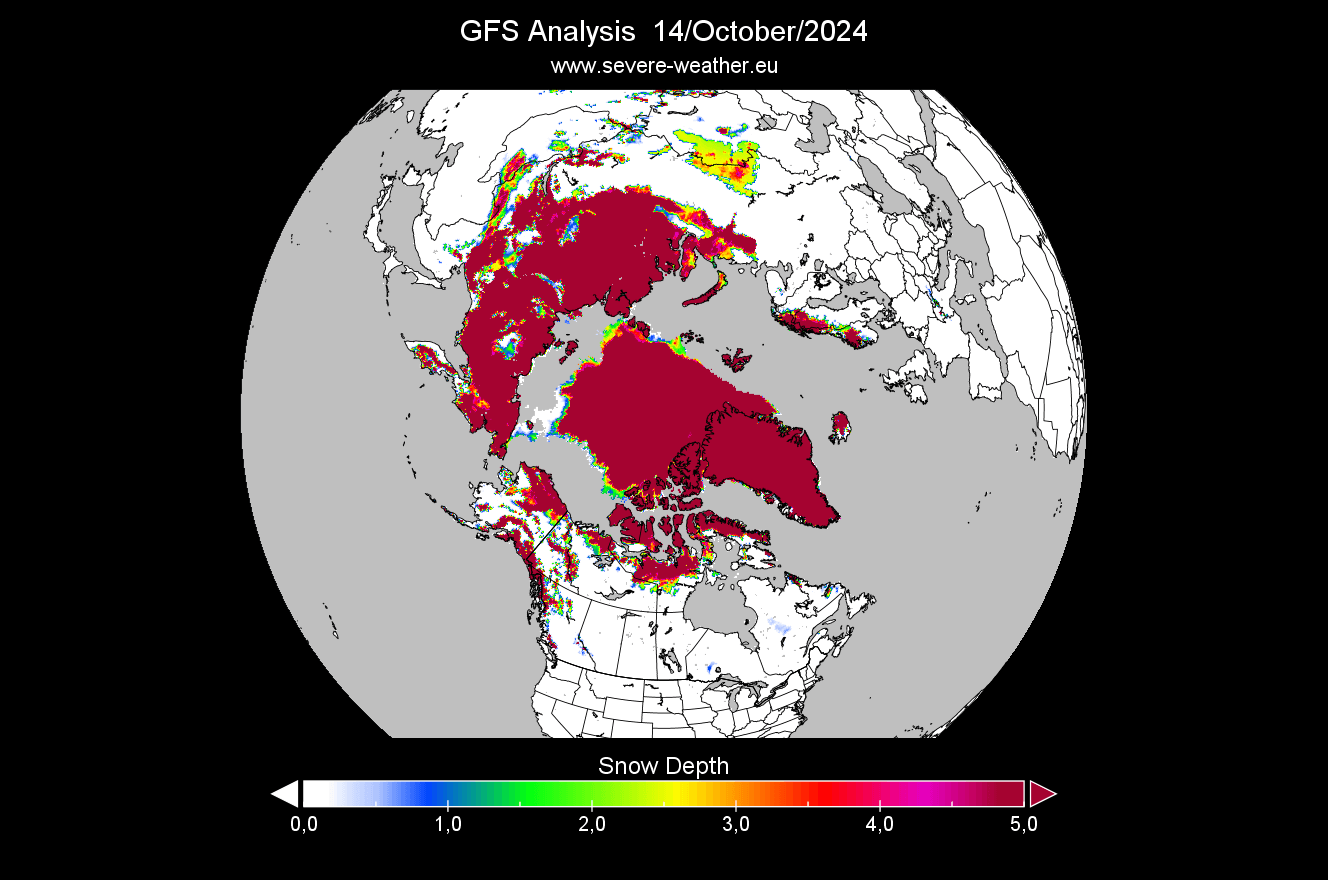
We can see the normals from Rutgers‘s snow cover anomaly analysis. It shows the snow cover from normal over the Northern Hemisphere. There is a large anomalous area of increased snow cover over Siberia, also seen in the analysis above.
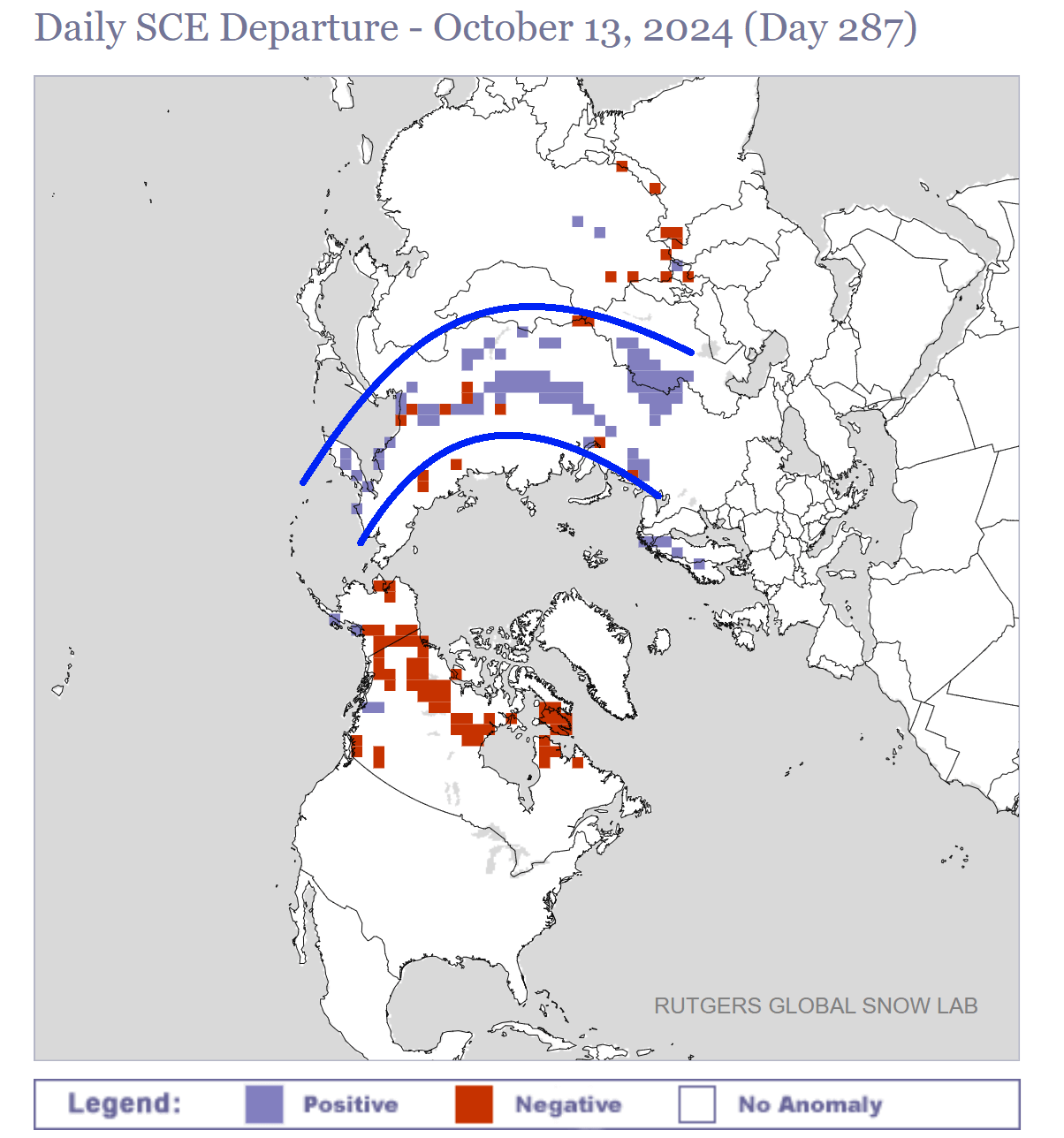
Currently, we are already seeing more snowfall than usual over Siberia. The graph below shows that the extent of snow cover over Eurasia is just over 10 million square kilometers, running above average for this time of year, and is the third highest in the past 20 years.
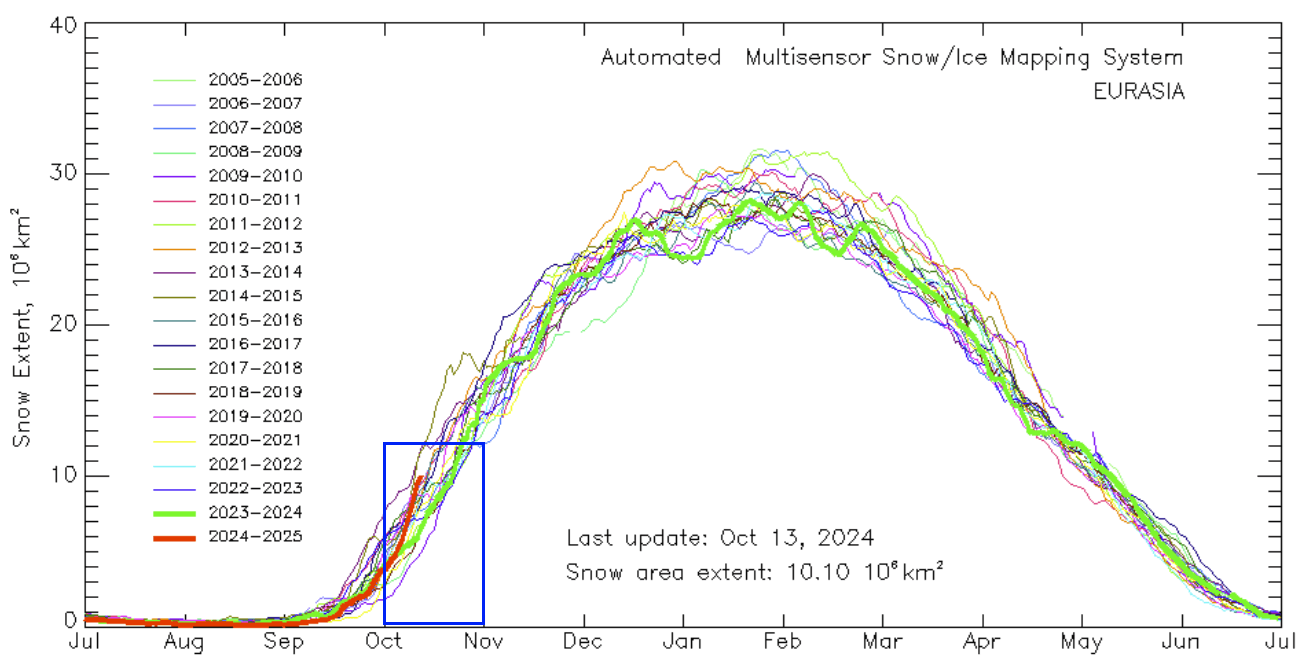
The next image is from the Canadian Cryosphere Agency and the Eurasian snow extent area anomaly. The latest data point shows a continued fast uptrend and above-normal snow area for this time of year.
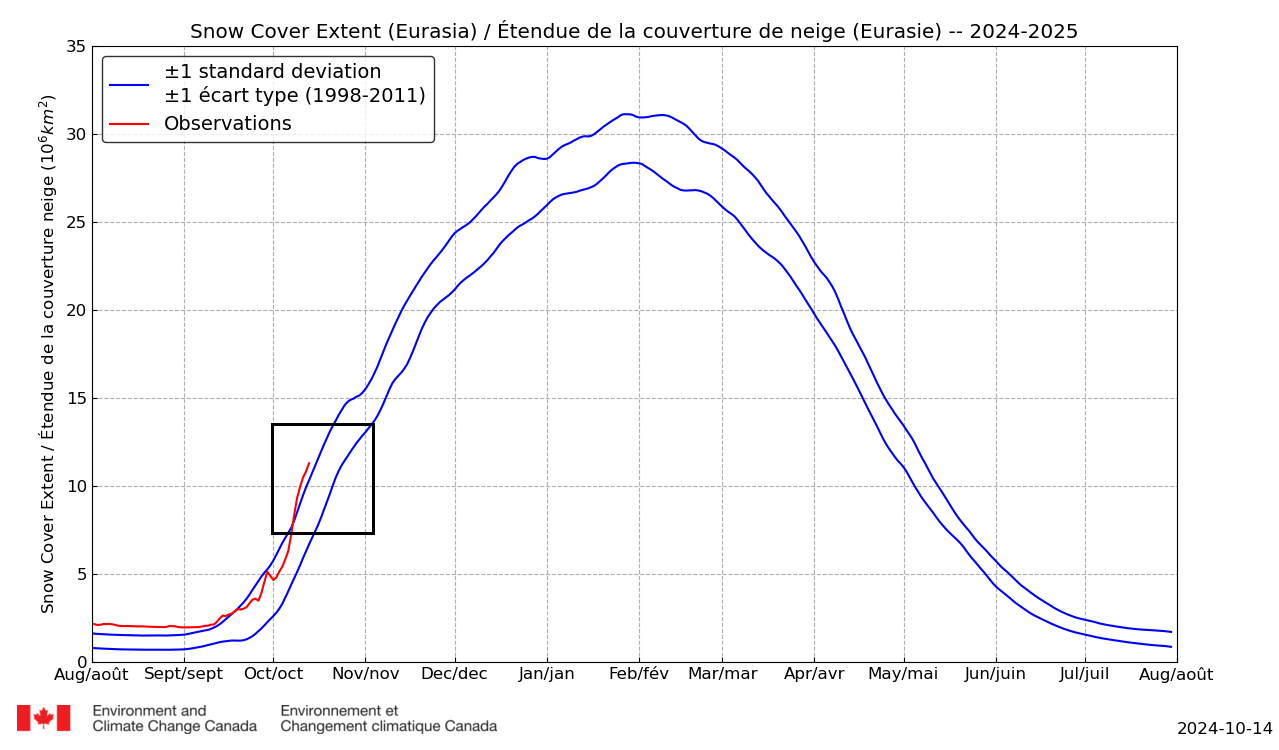
SNOWFALL FORECAST
There are still two weeks left of this month, so looking below at the 7-11 day pressure anomaly forecast, you can see a good pattern developing for more snow cover over Siberia. There is a broad low-pressure area forecast over that region, which should bring more precipitation and snowfall.
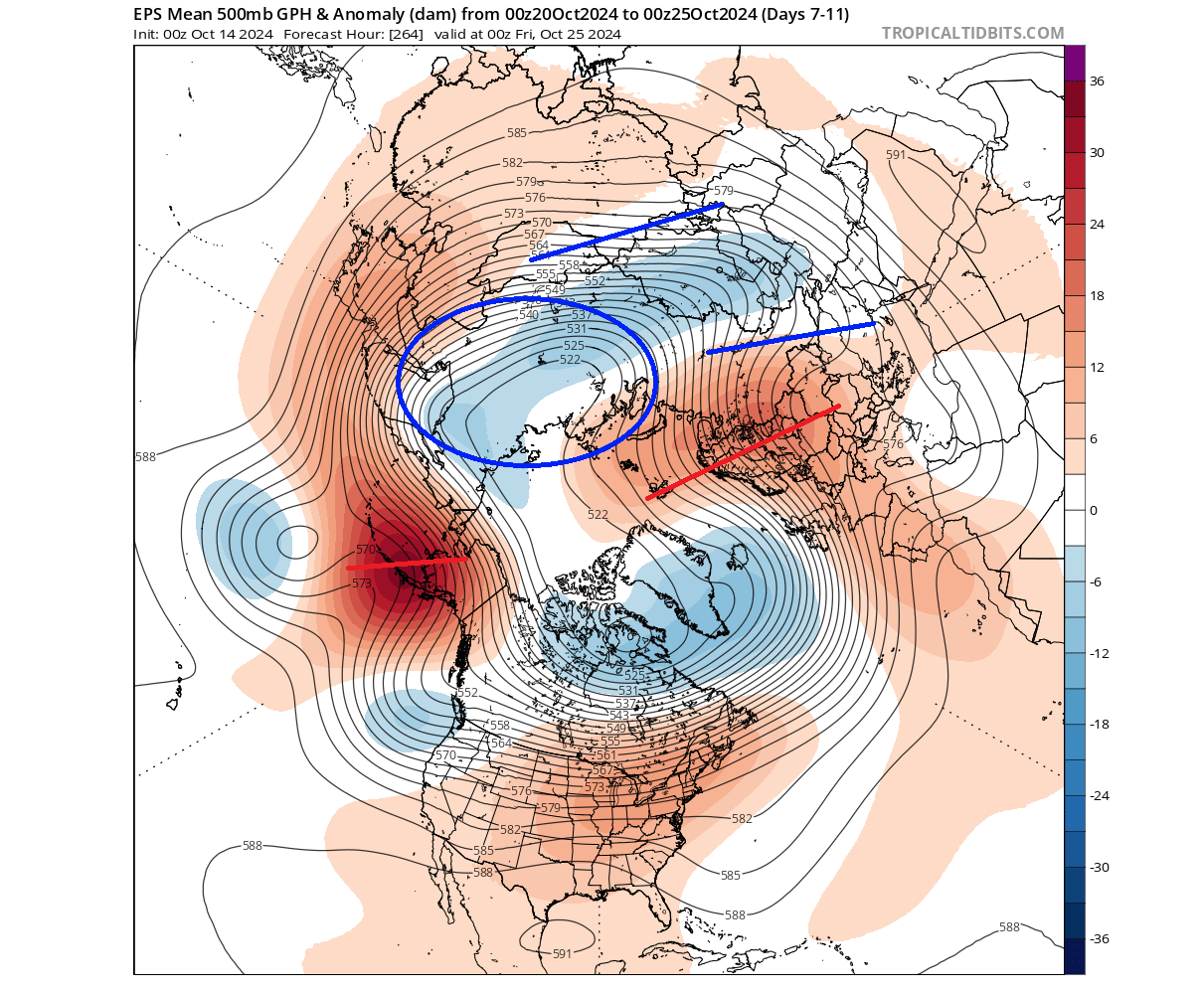
Looking below at the 16-day snow depth change forecast, you can see a substantial increase in snow depth and extent. Blue colors indicate snowfall and snow depth increase. All areas from North America to Siberia will expand the snow-covered area.
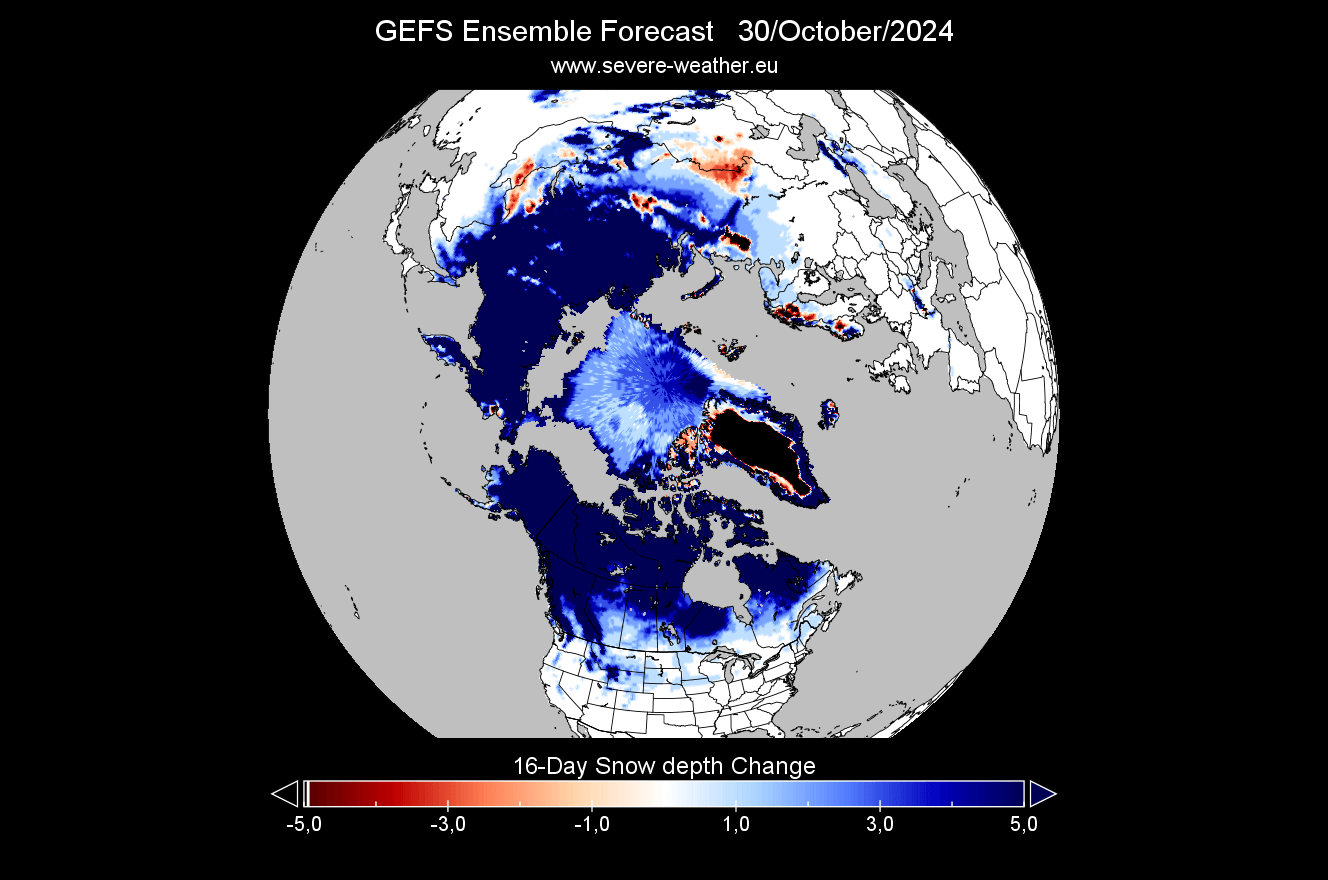
This is due to the supportive pressure pattern. You can even see some hints of snow patches over the northwestern United States in the Rockies and some hints over the far upper Midwest and the far northeastern United States.
But, what we cannot see from this forecast, is the departure from the normal extent for this time of the year. We will be able to see the anomalies from the analysis once available, giving us a more definitive idea of the potential role/impact of this year’s October snow extent.
EARLY 2024/2025 STRATOSPHERIC ANOMALY
Going directly to the stratospheric pressure anomaly analysis, you can see an unusual pattern. A high-pressure anomaly in the stratosphere at the western side of the Polar Vortex. This creates stress for the Polar Vortex, limiting its strength at a time when it should be rapidly strengthening.
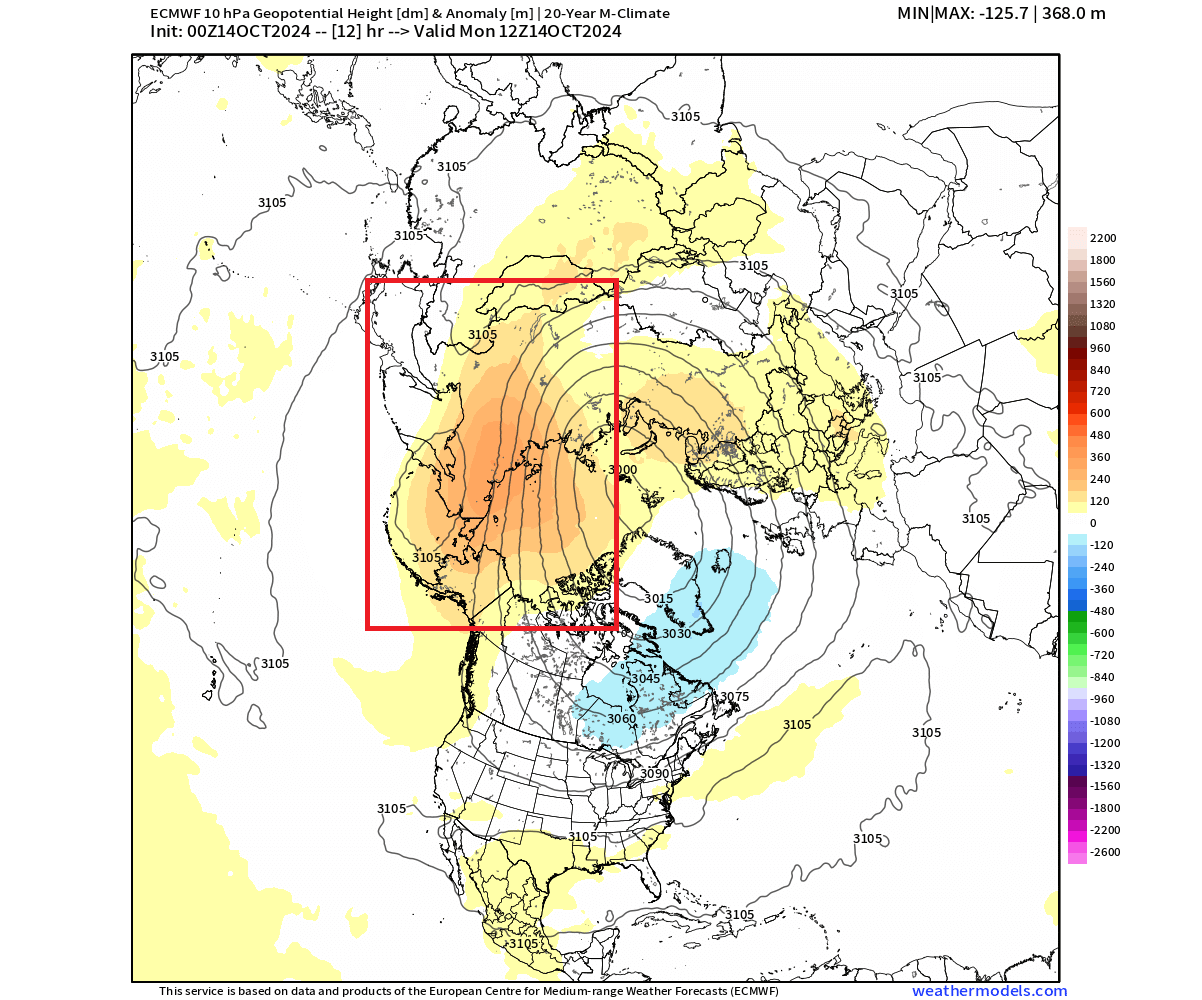
The temperature anomaly forecast for the stratosphere also shows a warming anomaly over the western half of the polar circle. This further shows how we are already starting with a weaker-than-normal Polar Vortex early in the 2024/2025 season.
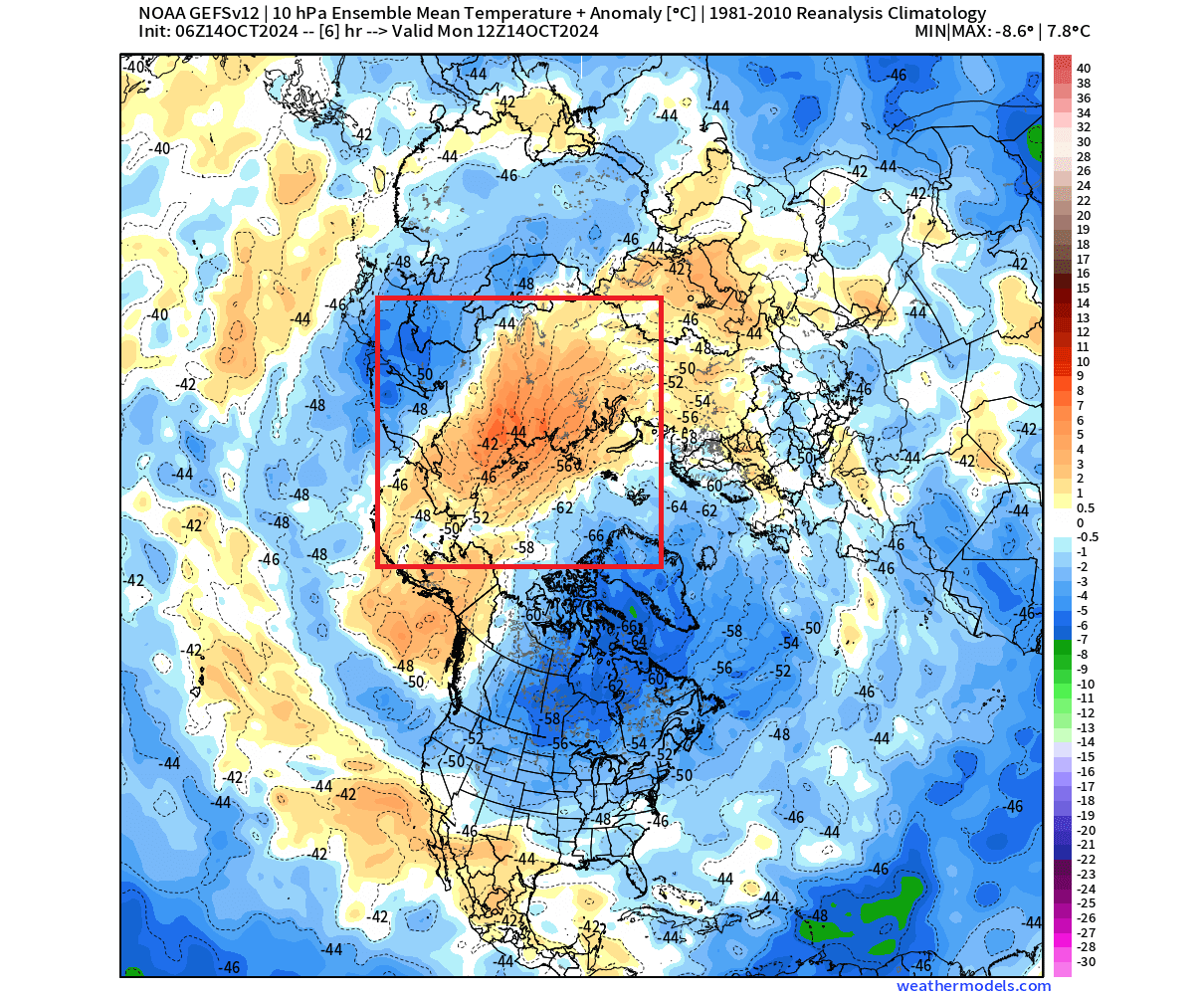
Below is the forecast for the 10mb stratospheric zonal winds. It shows a reduction in the stratospheric wind speeds in the December-January period. As winds are directly related to the strength of the Polar Vortex, we can see this as a signal for a weakening of the Polar Vortex, confirming the indications of higher snowfall in October.
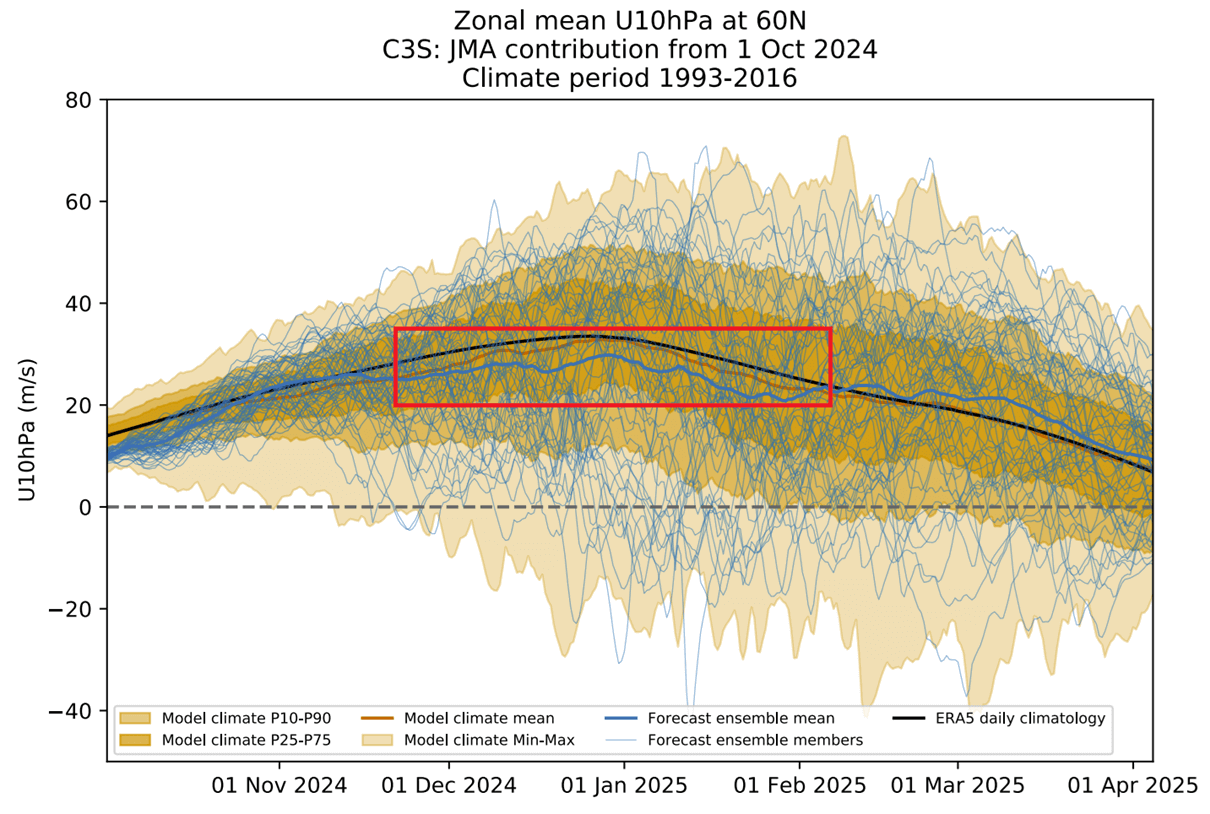
Every time you see a weakening of the winds around the Polar Vortex that is a direct indication that something is going on with the overall circulation. In most cases, a wind anomaly at this long range can indicate a potential Sudden Stratospheric Warming event in Winter.
POLAR VORTEX AND STRATOSPHERIC WARMING
To summarize, there is one main thing to take away from this development. As data shows, increased October snow cover over Siberia leads to a stronger high-pressure system over the region.
That high-pressure system helps to send more vertical energy into the Stratosphere during Winter. That energy can weaken and disrupt the Polar Vortex and the polar circulation.
If the Polar Vortex enters Winter in a weaker state, it is more susceptible to a full collapse event. As pressure systems get stronger and more energy goes upwards into the Stratosphere, it can reach a point where the Polar Vortex can completely collapse.
That is called a Sudden Stratospheric Warming (SSW) event and means a strong warming event of the Stratosphere and a following collapse of the Polar Vortex.
The image below shows the average temperature 0-30 days after an SSW event. It shows that most of the United States, along with Europe, end up colder than normal. Note: This is an average of several events, and individual results may vary.

Looking at snowfall, we can see above-average snowfall over much of the eastern United States and Europe after a Polar Vortex collapse event. Again, this is an expected response, as typically, after major stratospheric warming, the colder air has an easier path towards the south and into these regions.

As you can see, having a strong or weak Polar Vortex can significantly change Winter weather in the United States, Canada, and Europe. For this reason, we closely monitor the weather patterns and all activity surrounding the Polar Vortex.
We will keep you updated on the global weather pattern development for the coming seasons, so make sure to bookmark our page. Also, if you have seen this article in the Google App (Discover) feed, click the like button (♥) there to see more of our forecasts and our latest articles on weather and nature in general.
Don’t miss: